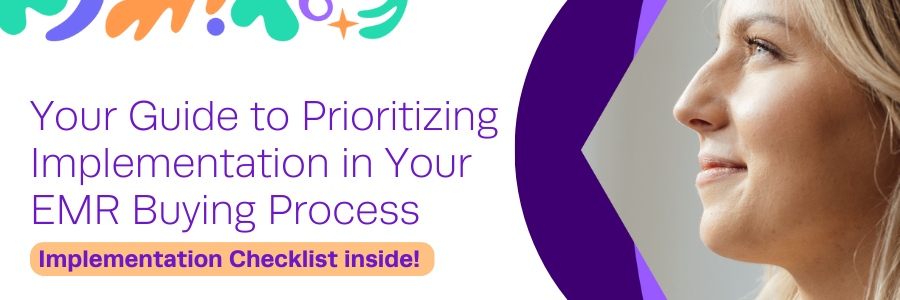Your Guide to Prioritizing Implementation in Your EMR Buying Process

Congratulations on your decision to purchase an electronic medical record (EMR) system for your behavioral health organization’s patient documentation and reporting needs! While you’re busy considering the right EMR software, have you thought about the implementation process? In this blog, we will explore the importance of implementation in the EMR buying process, the problems that arise from poor implementations, and provide a guide to help you prioritize implementation in your buying process.
Importance of Implementation in the EMR Buying Process
Before diving into the details, let’s clarify what implementation actually means. Implementation refers to the process of adopting and integrating the software into your organization’s workflows. It sets the foundation for your operational success with the new EMR system. A poorly executed implementation can lead to future problems and prevent you from realizing the full potential of the software. According to G2 Software Buyer Behavior Trends, 86% of software buyers consider a simple implementation as a very important or important buying consideration.
The Problems of Poor Implementations with EMRs
Imagine a scenario where implementation was not considered a vital criterion in the purchasing process. Here are a few problems that can arise:
- Delays in onboarding new clients: A poor implementation process can hinder your ability to efficiently onboard new clients, resulting in a loss of business opportunities.
- Disruption with your inpatient documentation: If you are switching EMRs, a poorly implemented transition can interrupt your patient documentation process, making it difficult to get reimbursed for the services provided.
- Increased costs: When an implementation project runs behind schedule, it can become costly due to additional resources and time required to rectify issues.
- Inefficiencies and errors: A poorly implemented EMR system can lead to inefficiencies, errors in data entry, and overall reduced productivity. More importantly, all these factors contribute to lower reimbursement rates due to poor data reporting.
The Pillars of a Strong Implementation
What qualifies a strong implementation? Not only should your technology partner provide you with an implementation plan that is customized for your facility, but it’s also a process that centers around three pillars: customization, training, and continuity.
Customization
Customization is essential to tailor the EMR system to align with your facility’s specific needs and workflows. By allowing customization, you can optimize efficiency and enhance patient care. Consider the following questions to determine if an EMR system offers robust customization options:
- Can the user interface and navigation menus be customized to match your facility’s preferences?
- Are there options to configure templates and forms according to your specialty or practice requirements?
- Can existing software systems be seamlessly integrated with the EMR for streamlined data exchange and improved operational efficiency?
Training
Proper training is crucial to ensure a smooth transition to the new EMR system. It empowers healthcare professionals to utilize the system efficiently and effectively, reducing resistance to change and enhancing overall productivity. Identify the types of training available, such as on-demand courses or in-person sessions, and ensure that training is tailored to different roles within your organization.
Continuity
When it comes to adopting a new EMR system, continuity plays a critical role in minimizing operational disruptions and facilitating a smooth transition. There are two key aspects of continuity to consider: initial system upgrade and ongoing uninterrupted operations.
- Initial System Upgrade: Maintaining a seamless system upgrade from one system to another is essential to avoid any hiccups in patient care and administrative processes. It’s crucial to understand the migration options offered by your vendor. Can they efficiently import patient data and case files within a reasonable timeframe? Can they establish an agreed-upon go-live date? By exploring these capabilities, you can ensure a timely and efficient transfer of essential information.
- Ongoing Uninterrupted Operations: Maintaining uninterrupted operations is crucial, especially when faced with staff turnover or the need to onboard new team members. As staff changes occur within your facility, it’s essential to ensure that the transition does not disrupt daily operations or compromise patient care. Consider the training and support needs of incoming staff members to guarantee they are proficient in utilizing the new EMR system. Your vendor should provide comprehensive training resources and ongoing support to address any challenges that arise. By prioritizing staff training and providing resources for continuous learning, you can minimize disruptions and maintain seamless operations even during periods of change.
Remember, implementation is a pivotal aspect of the EMR buying process that should never be overlooked. By placing a strong emphasis on implementation, customization, training, and continuity, you establish a solid foundation for operational success with your new EMR system. Evaluate each EMR’s implementation process based on these key pillars and refer to the Implementation Evaluation Checklist provided in this guide for an informed decision-making process. A well-executed implementation will maximize the benefits of your EMR system, leading to improved patient care and increased organizational efficiency.
Recent Posts
Rely on Kipu to keep you ahead of change.
Subscribe to Kipu for behavioral health news, updates, community celebration, and product announcements.



